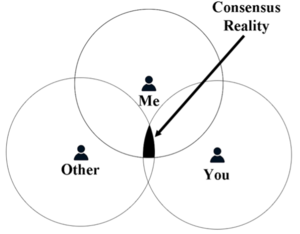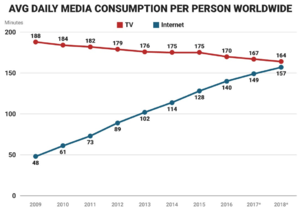Consensus Reality: Difference between revisions
mNo edit summary |
mNo edit summary |
||
| (5 intermediate revisions by the same user not shown) | |||
| Line 1: | Line 1: | ||
[[File:Consensus | [[File:Consensus reality.png|alt=Consensus Reality|thumb|'''Figure 1'''. Consensus Reality would be the common agreed upon reality where subjective perceptions overlap.]] | ||
''"There is one world in common for those who are awake, but when men are asleep each turns away into a world of his own."'' | ''"There is one world in common for those who are awake, but when men are asleep each turns away into a world of his own."'' | ||
– '''Heraclitus, 2500 years ago''' | – '''Heraclitus, 2500 years ago''' | ||
Consensus reality refers to the shared understanding of facts among a closed group of individuals or the general population at large. The concept suggests that by surveying people on specific topics, we can identify common agreements (see '''Figure 1'''). These shared agreements form a "''consensus reality''," acting as a common reference point for society. | |||
[[File:Tv.png|alt=Tv|thumb|'''Figure 2.''' Traditional centralised TV viewership has greatly declined vs more algorithmically personalised internet sources. ]] | |||
In the pre-internet era, when information sources were more centralized, larger consensus realities prevailed. However, with the rise of the internet, information dissemination has become increasingly decentralized (see '''figure 2''') and reinforced through [[Confirmation Bias|confirmation bias]]. Consequently, the notion of a singular consensus reality that binds society in a unified perception is gradually breaking down into smaller and more diverse subsets called [[Reality Tunnel|reality tunnels]]. | |||
Latest revision as of 08:21, 2 April 2025
"There is one world in common for those who are awake, but when men are asleep each turns away into a world of his own."
– Heraclitus, 2500 years ago
Consensus reality refers to the shared understanding of facts among a closed group of individuals or the general population at large. The concept suggests that by surveying people on specific topics, we can identify common agreements (see Figure 1). These shared agreements form a "consensus reality," acting as a common reference point for society.
In the pre-internet era, when information sources were more centralized, larger consensus realities prevailed. However, with the rise of the internet, information dissemination has become increasingly decentralized (see figure 2) and reinforced through confirmation bias. Consequently, the notion of a singular consensus reality that binds society in a unified perception is gradually breaking down into smaller and more diverse subsets called reality tunnels.

